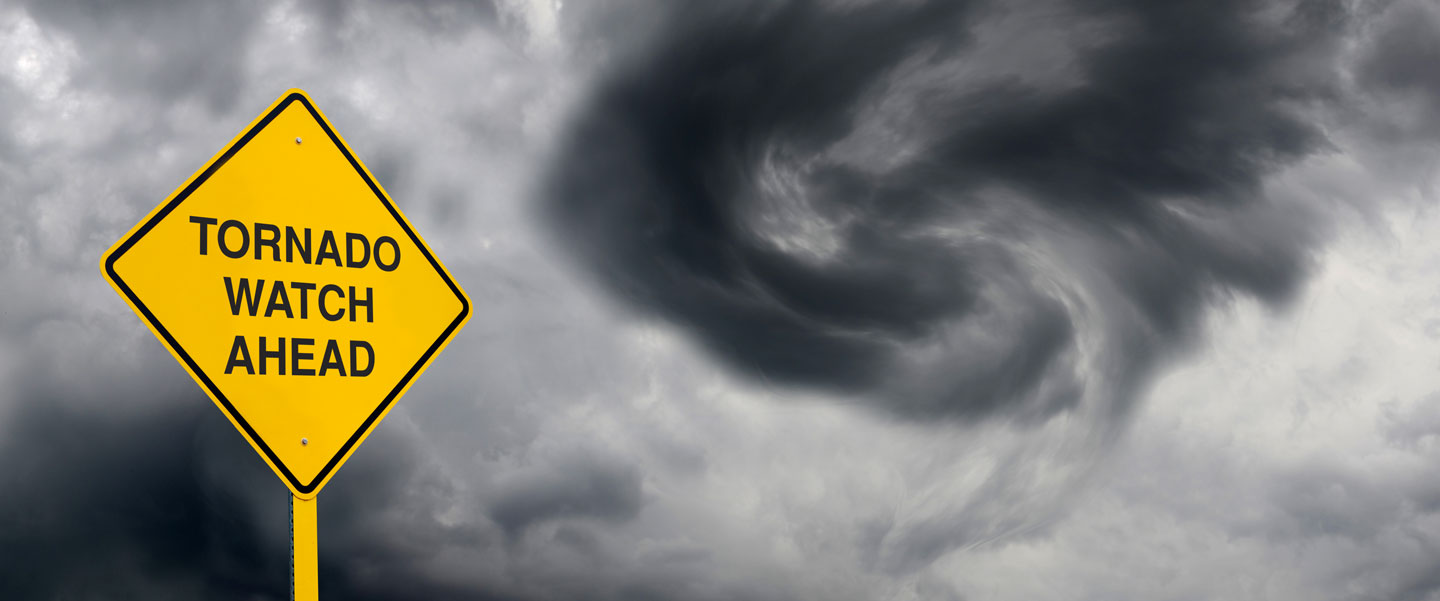CATEGORIES:
Tornado Warning Signs and Preparation
April 15, 2020

Tornadoes, as we have pointed out before, can form on any day of the year, and at any time of the day. And, although some regions are more prone to these destructive twisters than others, tornadoes have struck all 50 states. Of course, if you live in Tornado Alley or Dixie Alley, the threat of deadly tornadoes is greater than in most other parts of the country.
Unpredictability is one of the main features of tornadoes, and a huge reason why they are often so deadly. If a tornado is rampaging across the landscape, we can’t say which direction it will head or how long it will even last. These dangerous storms often give very little warning before their formation.
That said, there are conditions that favor the formation of tornadoes. Being able to spot them, and having a mind to respond quickly and appropriately, may literally mean the difference between life and death for you and your loved ones.
How Tornadoes Form
Scientists still don’t know everything about how tornadoes form and how they die. What they do know is that thunderstorms normally give birth to tornadoes, and that storms require the clash of warm humid air which rises to meet colder air higher in the atmosphere.
Once a thunderstorm becomes a supercell, or a meteorological system that has a large rotating vortex within it known as a mesocyclone, conditions become more favorable for tornado formation. The next stage involves an updraft that sets the mesocyclone spinning vertically. When this cloud-based rotating column spins rapidly enough and then makes contact with the ground, it becomes a full-fledged tornado.
Tornadoes Often Strike with Very Little Warning
Obviously, if you see a huge funnel cloud in the sky, that’s a sign of impending tornado danger. You may also hear a roaring sound that resembles a freight train, and see flying debris. Unfortunately, sheets of heavy rain can often make it difficult to spot hidden, accompanying tornadoes, thus reducing what is already often a very short warning period.
Large hail and a sky that looks almost green may also serve as warning signs of an impending tornado. Of course, these components are not surefire indicators, nor are they in any way necessary for tornado formation.
Twisters can spring up with little notice and won’t always be visible. And since most of us aren’t dedicated storm chasers, we have to depend on meteorologists, governmental authorities, and other specialists to give us advance notice.
Fortunately, we are better at forecasting tornadoes than we used to be.
Tornado Watches and Tornado Warnings
You have probably heard the terms “Tornado Watch” and “Tornado Warning.”
If the National Weather Service has issued a Tornado Watch for your area, this means that conditions are right for tornadoes to form. The area covered by a Tornado Watch might include multiple counties or even an entire state.
A Tornado Warning indicates that an actual tornado has been observed via radar or firsthand by a trained spotter (often a first responder or a public utility worker). The area covered by a Tornado Warning is typically smaller than that encompassed by a Tornado Watch, indicating imminent danger.
Advance Tornado Preparation
Even before the National Weather Service issues a Tornado Watch or a Tornado Warning you should be prepared for one. Have a designated storm shelter in place, emergency supplies stocked, and a readymade plan for getting yourself, your family, and your pets to safety.
And you should practice for the worst-case scenario. Run tornado drills at home so that you aren’t stuck figuring things out in the middle of an actual twister.
Consider this: Most of the tornadoes that struck Nashville and other parts of Tennessee during the first week of March 2020 did so in the middle of the night. Waking up to a Tornado Warning and an impending twister is not the best time to start figuring out a preparedness plan.
What Should You Do in the Event of a Tornado Watch or a Tornado Warning?
If you live in an area under a Tornado Watch, it’s time to prepare yourself and your family to take shelter. Double check your safe room and all of your emergency supplies.
Your tornado preparedness kit should definitely include a flashlight (powered by batteries or a hand crank), a battery-powered radio (for monitoring the latest weather alerts), extra batteries, a first-aid kit, and any necessary prescription medications. Having a reserve of potable water and canned food is also a good idea.
In the event that the National Weather Service upgrades their alert to indicate a Tornado Warning, then it’s time to put your plan into action! Get to your shelter immediately, and remain there until authorities declare that the danger has passed.
Where Not to Go in the Event of Severe Weather
There is a long list of places that you absolutely should not be in the event of severe weather, if you can possibly avoid them.
If you live in a mobile home, you should leave it and get to a sturdier building. Find out ahead of time if your neighborhood or mobile home park has a community shelter where you and your family might be able to take refuge.
A vehicle is not a good place to be either. If you’re on the road when severe weather hits, try to get to a truck stop or some other well-built structure. Avoid trying to ride out the storm under a highway overpass as this won’t protect you from being struck by flying debris or swept away by floodwaters.
A Dedicated Storm Shelter is Best
The best way to protect yourself and your family from tornadoes are with a storm shelter specifically designed for that purpose. If you’re in your home and the authorities issue a Tornado Warning, but you don’t have a shelter, at least move away from any and all windows and get as low and as far from exterior walls as possible, making sure to protect your head and neck.
Obviously, you will want to have your safe room securely in place and stocked with any necessary supplies before the threat of severe weather arrives.
Consult the safe room professionals at Survive-a-Storm. We can help you decide which tornado shelter is most appropriate to meet your needs. With above ground storm shelters and underground storm shelters available, we’re confident that we can provide the best solution for you.




